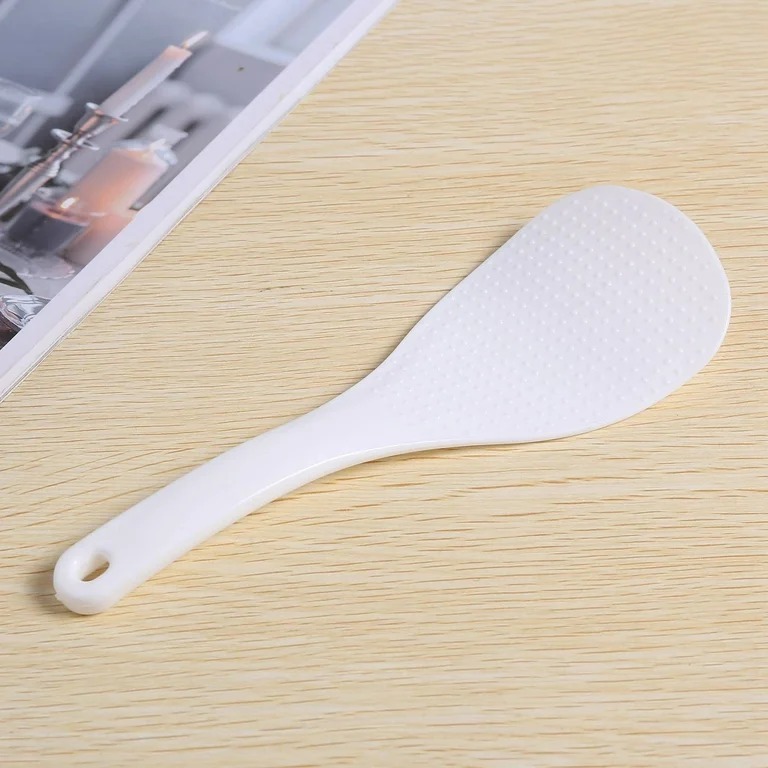ADVERTISEMENT
## Chapter 3: The Science Behind the Design
### 3.1 Why Bumps and Not Smooth Surfaces?
At first glance, it may seem like a smooth spoon would be just as effective for scooping rice. After all, smooth surfaces are often easier to clean, and there’s no reason why they wouldn’t function just as well. However, the bumps on the rice cooker spoon are strategically placed to address several challenges inherent in the process of cooking and serving rice.
#### 3.1.1 Dealing with Rice’s Sticky Nature
Rice, particularly white rice, has a natural tendency to stick to surfaces due to its high starch content. When rice is cooked in a rice cooker, the heat and moisture cause the starches in the rice to become sticky. A spoon without any texture might cause the rice to adhere to the surface, making it harder to serve. The bumps help to break this adhesion by creating small spaces between the rice and the spoon, allowing for a smoother and less sticky serving experience.
#### 3.1.2 Maintaining Rice’s Light and Fluffy Texture
When rice is cooked, one of the goals is to maintain the light, fluffy texture that makes it so enjoyable to eat. The bumps on the back of the spoon help maintain this by preventing compression. Smooth, flat spoons would flatten the rice, leading to a denser texture. The bumps, on the other hand, gently lift the rice, keeping the grains separate and airy.
This is especially important when cooking larger batches of rice, where the rice cooker is often full. The bumps help to distribute the pressure more evenly, ensuring that the rice remains light and fluffy, even if it’s packed in tightly.
—
## Chapter 4: Tips and Tricks for Using a Rice Cooker Spoon
### 4.1 Fluffing Rice After Cooking
One of the key advantages of using a rice cooker spoon with bumps is the ability to fluff the rice effectively. After the rice has finished cooking, it’s a good idea to use the spoon to fluff the rice by gently stirring it. The bumps on the spoon help to create the right amount of separation between the grains, ensuring that you end up with perfectly fluffy rice rather than a dense, sticky mess.
### 4.2 Using the Spoon for Other Purposes
While the primary use of the rice cooker spoon is to serve and fluff rice, it can also come in handy for other tasks in the kitchen. For instance, the spoon can be used to mix other grains like quinoa or couscous in the rice cooker. Its broad shape and ergonomic design make it ideal for stirring, and the bumps ensure that the grains don’t stick to the spoon while mixing.
### 4.3 Cleaning the Rice Cooker Spoon
Given that the spoon is often made from plastic or wood, it’s important to clean it carefully to avoid damaging the surface. The bumps on the back of the spoon can sometimes trap small amounts of rice or debris, so it’s a good idea to wash it with warm, soapy water after each use. You can also use a gentle scrub brush to clean between the bumps to make sure no rice particles remain.
—
## Chapter 5: The Future of Rice Cooker Accessories
### 5.1 New Features in Modern Rice Cookers
As technology evolves, so do rice cookers and their accessories. Many modern rice cookers come with advanced features like **fuzzy logic** (which adjusts cooking times and temperatures automatically), **keep-warm functions**, and **multi-functional settings** for cooking different types of rice, grains, and even porridge. It’s possible that future rice cookers will have additional tools or specialized spoons with new features aimed at improving the cooking and serving experience even further.
While it’s difficult to predict exactly what innovations might come in the future, the humble rice cooker spoon, with its functional bumps, will likely continue to play a key role in ensuring the best results for your rice. For now, the bumps remain a clever and simple design feature that makes a huge difference in the kitchen.
—
## Conclusion
The bumps on a rice cooker spoon are not just a quirky design feature; they are a carefully thought-out addition that serves multiple purposes in the cooking and serving process. Whether it’s preventing rice from sticking to the spoon, reducing clumping, or maintaining a light and fluffy texture, these small bumps play a vital role in improving the quality of your rice.
As we’ve seen, the history of the rice cooker is rich with innovation, and the development of the rice cooker spoon, with its specialized bumps, is just one example of how manufacturers have focused on enhancing the cooking experience. So the next time you cook rice, take a moment to appreciate the thoughtful design of the spoon that helps bring your dish to perfection!
Whether you’re a novice cook or a seasoned pro, understanding the purpose of these small details can elevate your culinary skills and help you make the most of your kitchen tools. Happy cooking!
